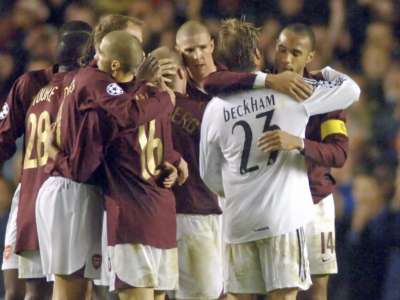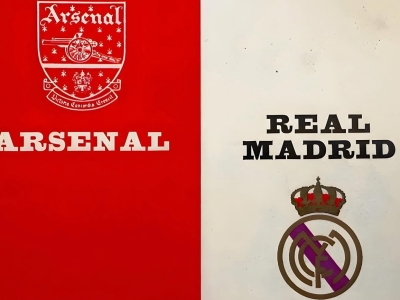For a club whose footballing reputation, for most of the previous 100 years, has largely been one founded upon its resilience, discipline, and appetite for a fight, Arsenal’s teams down the years have never-the-less been ones gilded by more than the occasional intelligent, elegant, or sheer ruthless forward. For much of our history the plan has been straightforward: resilient organisation constructed around a potent goal scoring figurehead. Indeed, since the days of Bertie Mee, which for me mark the beginning of the period of ‘modern Arsenal’, for every John Hawley, John Kosmina, or Fabian Caballero there has been a John Radford, Frank Stapleton, Ian Wright, or Dennis Bergkamp: a spectrum which runs in all its many shades of prowess, or otherwise, from, at one end, Ray Hankin to Thierry Henry at the other.
Once was the time when good things came in pairs: the seventies gave rise to Radford and Kennedy; Macdonald and Stapleton; then Stapleton and Sunderland.
Although the heart remembers the verve and brio of Charlie George’s contributions to the 1971 double, the head might prefer to make a case for the input of Radford and Kennedy as being more telling over the course of the season? Radford scored only once in the final 19 matches of the season, while Kennedy netted six times during the same period, however the strike pair frequently set the tone: 90 minutes of graft: running, chasing, and closing down: it must have been inspiring for midfielders and defenders to see their forwards also defending so committedly from the front; a very real sense of all for one and one for all?
A young Frank Stapleton was once described as one of the least naturally gifted footballers of his generation but recognised as a man who utilised every last little bit of what ability he had at his disposal; assisted by his mercurial work ethic and technical application he more than compensated for the fact he wasn’t a Charlie George in terms of raw ability alone. I remember the scruffy goals he scored, and the headers, like the seismic winner at Forest in the FA Cup in 1979, and also that inexplicable miss in the 1978 League Cup semi-final at Highbury. Like Radford, Stapleton set the tone for the team, an ideal number 9, who would fight for everything and never give up on a cause. He very slightly pre-dated Malcolm Macdonald at Highbury, being one of a hugely impressive group of youngsters the departing Bertie Mee bequeathed to Terry Neill. On Neill’s accession he announced his ambitions for the club by signing Malcolm Macdonald. After an up and down first season, Macdonald and Stapleton spearheaded Arsenal’s emergence as London’s likely lads, playing with a bit of dash not seen for a while Macdonald scored 29 goals in his first season and 26 in his second before suffering a knee injury at the start of the 1978/79 season from which he never recovered.
Macdonald’s replacement was Alan Sunderland, who had been signed from Wolves the previous season as an ‘old fashioned’ outside-right, but converted by Neill and coach Don Howe into a striker. In many ways he was a more suitable partner for Stapleton, who was the ideal target man; Sunderland was more mobile than Macdonald and prepared to work outside of the penalty box in a way that Supermac didn’t. Bill McGarry, Sunderland’s manager at Wolves had described him as the best finisher he ever worked with but that his versatility sometimes worked against him: he played right-back, midfield, right wing, and forward at Wolves and thus became the perfect substitute. He flourished at Arsenal alongside Stapleton, and of course committed his name to Arsenal folk lore with his 89th minute Wembley winner in 1979. I remember the calmness of his lob over Clemence at Villa Park to equalise against Liverpool in the first of many subsequent replays of the 1980 cup semi-final too, a sequence of games eventually settled by Brian Talbot: ‘Sunbeam’s’ header clinching it in the third replay.
The late eighties saw Alan Smith’s move to Highbury where he was first paired with a young, rascally Paul Merson; then Kevin Campbell, and eventually Ian Wright. On paper Smith and Wright perhaps should have been the best of the bunch, with almost every desirable facet of the forward’s armoury contained within them? But Smith has spoken of the unsettling effect Wright had on his game; the spontaneity and unpredictability, which were perhaps alien to Smith’s own approach? Still he will always be remembered for his goal at Anfield ‘that night’, and his uncharacteristic strike from distance in Copenhagen, 1994.
Bruce Rioch’s brief tenure as manager’s at least yielded the mouth-watering sight of Wright paired with the elegant genius of Dennis Bergkamp for twelve months. But once Wenger had been installed, the French prodigy, Nicholas Anelka quickly usurped Wright in Wenger’s favour, perhaps Wenger saw Anelka as the more likely beneficiary of cutbacks from Overmars galloping down the wing, or through balls from Bergkamp, or even Petit? Wright tended to curve his runs, or make then diagonally, whereas Anelka’s pace was such that he simply out sprinted everyone running in a straight direct line, and his arrival at point X in the box, coinciding with an Overmars’ pass was perhaps just that little bit more predictable than with Wright? Wenger certainly took the view that Anelka’s directness was easier to integrate into a unit than Wright’s individuality.
Until Wenger began experimenting with a positionally and structurally more fluid system Arsenal still played with a notional two up front, although with one ‘in the hole’ and we saw what felt like an almost continuous conveyor belt of an approximation of the world’s best forwards on a Saturday afternoon: Kanu, Davor Suker, and Van Persie with admittedly the odd Kaba Diawara thrown in: perhaps Diawara being the sausages after the caviar that Wenger eluded to around this time?
For a brief time the attacking double act became a secular holy trinity of Henry, Bergkamp, and Pires the architects of some of the most sublime football ever played at Highbury: how fitting that the history of that beautiful cathedral of football culminated in a couple of seasons of those three in their glorious pomp?
The arc of history from Radford and Kennedy to Pires, Henry, and Bergkamp is one that stands well the test of critical analysis in terms of goal scorers, and this is without even referencing such almost luminaries as Charlie Nicholas, Tony Woodcock, or Brian Kidd.
Over this period we’ve had some fine ‘keepers, great combative centre halves, and deftly scheming midfield generals too; but it is the forward who perhaps stays longest in the memory from those great teams of the past, their images forever frozen in time: Kennedy in mid-air as his header flies in en route to the title in ‘71; Bergkamp’s twizzling pirouette at St James’ Park, or Henry falling as his shot screams in at the Bernabéu: the celebrations too: Alan Sunderland arms aloft at Wembley in 1979, and my own favourite – Radford amidst the streamers and loo rolls contorted with delight moments after heading Arsenal’s second against Anderlecht in 1970; but there’s also Thomas at Anfield; and…and…all of them great football moments which transcend the mere narrowness of football and spill over into the stories of all our different lives though lives bound together around the story of Arsenal; memories which never fade, but stand proudly beneath the banner of Victoria Concordia Crescit!
_______________________________________________________________
The campaign to save The Gooner for the 2020/21 season is in progress. If you wish to see the fanzine continue printing after the end of the current season, details of how to subscribe can be found here. If you wish to order with a credit card, go straight to our online store page here. We need to secure 1,000 subscribers by the end of March 29th to continue.
The current issue of The Gooner (282) is on sale from our online store. You can order your copy here (for UK orders) or if you are abroad, order here.
_______________________________________________________________
You can follow The Gooner on
Twitter
Facebook
Instagram
or subscribe to our
YouTube channel (where you can find the GoonerFanzineTV weekly podcast)








